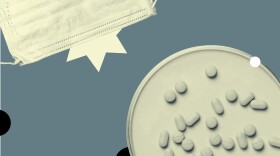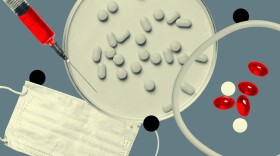In a hard-drinking, 24-hour town, a new form of a drug holds hope for recovering alcoholics
Eric Mathis had the roommate from hell. This roommate was constantly making noise, disrupting Mathis’ sleep, ruining his solitude, screaming and shouting at all hours. The roommate was constantly urging Mathis: Come on. Let’s party. Have a drink.
The roommate lived inside Mathis’ head.
“When you’re an alcoholic, trying not to drink is like having a really important homework assignment due the next day, but you have this really loud roommate. The roommate is that voice, that addiction, that pull telling you to drink,” he says. “You really can’t focus because it’s always there.”
Beer was Eric’s beverage of choice. His way of unwinding after work was three or four 24-ounce Bud Lights. His alcoholism marred his college years, ruined his marriage and jettisoned a promising career in the military. (Mathis says he actually joined the military hoping the environment of order and discipline would drum the desire to drink right out of him; instead, he found that the hard-partying atmosphere managed to thrive outside the rigorous schedules and drills.) But it wasn’t as though Mathis hadn’t tried to get help.
“I’ve been to 30-day detoxes, 12-step programs, and when you’re there, you feel awesome,” he says. “You feel, this is what I need. But as soon as you walk out that door, that craving says, ‘Well, that was cool.’ It didn’t do anything for the physical aspect. That’s the hardest. You can want (to quit drinking) all day, but that voice never shuts up. Sometimes it’s all you can hear until you satisfy it.”
[[field:story]]
When he discovered that there’s a medication shown to help alcoholics kick drinking for good, he leapt at the opportunity. As a client of Start Fresh Recovery, a drug and alcohol addiction treatment center, Mathis began taking naltrexone tablets March 11; three weeks later, he replaced those with a slow-release naltrexone implant, surgically embedded just below his beltline, that lasts from nine to 12 months. He also receives life-coaching sessions to help him navigate the everyday enticements of bars, parties and casual drinking. The Start Fresh premise: Chemically quashing alcohol cravings for up to a year gives people in recovery plenty of runway to get their lives together again, time to rewire their habits and recast their behaviors. Today, the roommate clamoring in Mathis’ mind: silenced.
Buzz kill
“Naltrexone extinguishes the desire to drink,” explains the Las Vegas clinic’s Executive Director Bonnie Barnett. Called an opioid antagonist, naltrexone works by blocking the receptors in the brain that alcohol interacts with to make you feel intoxicated. The tablet has been used in treating alcoholism since the ’90s, but the implant form, developed in Australia, has only been available in the U.S. for about five years. Santa Ana, Calif.-based company BioCorRx developed the Start Fresh program in 2010, coupling naltrexone implants with life coaching. As the website tells it, BioCorRx co-founder and President Neil Muller launched the treatment program after watching his then-fiancée Deidre struggle with alcoholism for 14 years. Individual Start Fresh Recovery clinics use the program, but are independently owned.
Just as important as the pharmaceutical technology, though, is what naltrexone’s adoption as a treatment for addiction says about the changing perception of alcoholism.
“The growing popularity of medical-assisted therapy means maybe there’s a groundswell of understanding that the white-knuckle, behavioral approaches to treating alcoholism — that look on it as a moral failing — don’t work,” says Barnett.
“It’s only in the last seven to 10 years that we’ve really started talking about alcohol and drug abuse in terms of a disease model,” adds Paul Kapsar, director of patient care services.
Mathis certainly tried to cure his disease with a variety of methods. Even when he told his superiors in the Air Force he had a drinking problem, he was surprised how unenlightened the response was. “I was told to suck it up,” he says. “You’re treated like you’re weak.” While in the military, he was finally admitted to a treatment program, which included a stint in inpatient rehab in Las Vegas. “They basically locked me up for 30 days. But they might as well have picked me up in a beer truck as soon as they dropped me off, because that craving never went away.”
'i switched brains'
Given Las Vegas’ high profile as a 24-hour party town, you’d think Start Fresh Recovery would have problem drinkers knocking down its door. As the Strip goes, so goes Nevada: We like to drink. The Centers for Disease Control studies rank Nevada near the middle for prevalence of adult binge drinking, and high for intensity of binge drinking. In other words, Nevadans binge drink (i.e., consume five or more drinks on a single occasion for men, four for women) with average frequency; but when we do binge drink, we do it intensely, consuming about seven drinks per occasion.
But there are complications. Since Start Fresh Recovery opened in Las Vegas in September, it’s taken on 16 clients. Part of that is because the naltrexone implant is relatively new — and relatively unproven. While many clinical studies show oral naltrexone can help reduce heavy drinking and frequency of heavy drinking episodes, naltrexone implants are a different story. Given its relative newcomer status, there isn’t much published research addressing whether it works.
That means the implant version of naltrexone isn’t yet approved by the FDA. And that, in turn, means insurers are reluctant to cover it. For instance, in a policy bulletin, Aetna Insurance calls the implants “experimental and investigational” because of “insufficient evidence in the peer-reviewed published medical literature of their safety and effectiveness.” And that means those seeking treatment have to pay out of pocket for the implant. It’s $15,500 for the course of treatment, $17,000 on a payment plan.
Barnett cites internal, unpublished research that claims an 80 percent success rate of naltrexone implant users successfully abstaining from alcohol, versus a 70 percent failure rate with naltrexone taken orally. Why the big difference? Alcoholics can forget to take their tablet — or skip it on purpose.
“The implant is the answer to that,” says Barnett. “With the whole nine-month curve of coaching and behavior change, that habit has changed, and it has to change along with an absence of craving. The implant is so much more effective than any other method, and until somebody ponies up the time and money to put it up through FDA approval, it’s going to be expensive.”
But if you ask Mathis, it’s a small price to pay in exchange for rescuing years, relationships, careers from the whirlpool of alcoholism. “It’s like an elephant getting off your chest. There’s no telling where I would have been in life had I found this back when I first identified there being a problem.”
While there aren’t yet a lot of studies about naltrexone implants, Mathis’ personal story is compelling, and his passion about how the drug changed his life is palpable. Today he works in a local casino — and says he can walk past a casino bar or cocktail tray without so much as a second thought. And when he gets home after a long day, he unwinds in a dramatically different fashion than he used to.
“This is gonna sound weird, but every night after I get off work, I sit in my living room. I don’t do anything. I don’t turn the TV on. I just sit and enjoy the silence. Because for 15 years, there was that voice, that unrest, that, ‘Go get your beer.’ Now it’s gone, and it’s so peaceful, so pleasant. It’s like I switched brains with somebody.”









